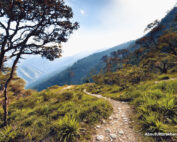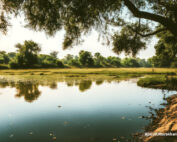Traditional Utensils Of Uttarakhand
Situated in the foothills of the Himalayas, the state of Uttarakhand is home to a vibrant cultural history that is inextricably linked to the environment. Uttarakhandisand#39; traditional cooking implements are one thread in their rich cultural fabric. These implements are symbols of the local communitiesand#39; resiliency and ingenuity; they are functional in everyday life and bear the weight of traditions that date back millennia.
Table of Contents
Traditional Utensils Of UttarakhandDetails About Traditional Utensils Of Uttarakhand
Types Of Traditional Utensils Of Uttarakhand
Bari
Bhaddu
Bhagona
Cast Iron Kadai
Cast Iron Tawa
Chakki
Chalni
Dona and Pattal
Gagar
Imam Dasta
Kansa Thali
Ketli
Letan
Parat
Paredu
Parothi
Patila
Rodi
Sil Batta
Suppa
Metal Used And Physical Construction Of Traditional Utensils Of Uttarakhand
Use Of Traditional Utensils Of Uttarakhand In Daily Life
To Conclude
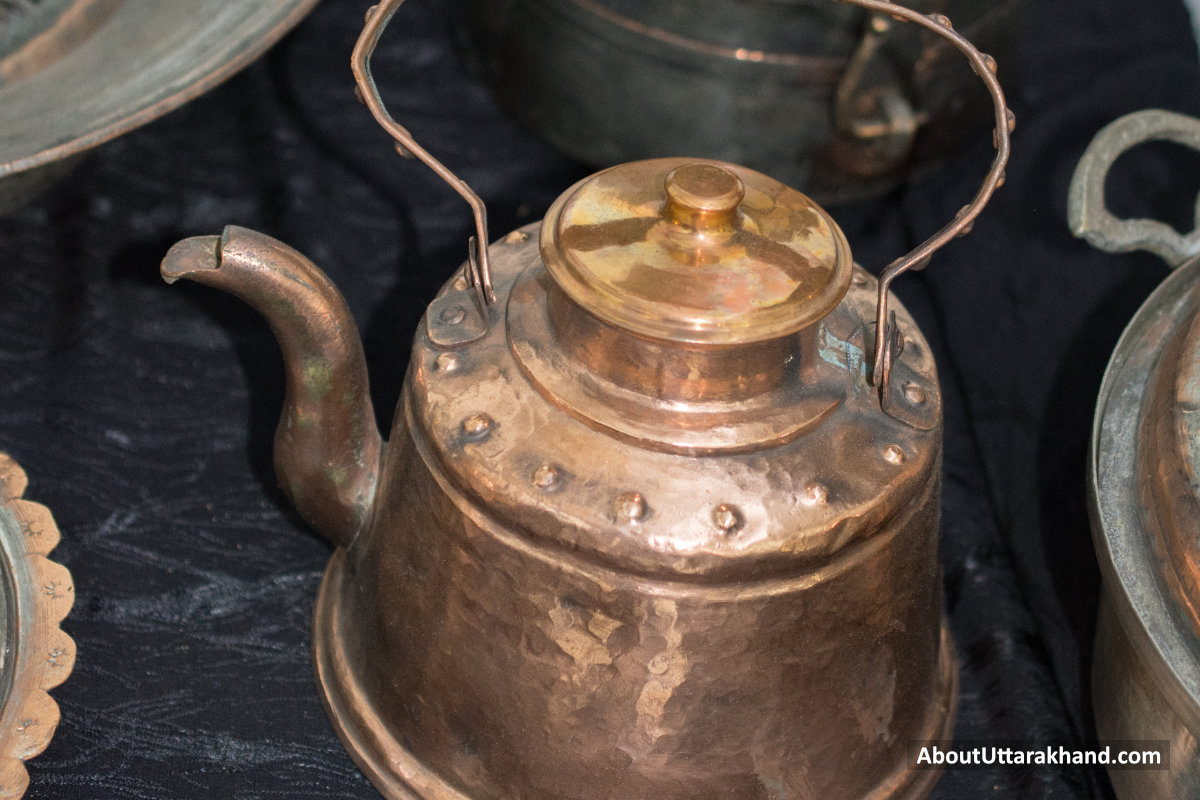
Traditional Utensils Of Uttarakhand | Photo By: About Uttarakhand
Details About Traditional Utensils Of Uttarakhand
Uttarakhand, famous for its stunning scenery and cultural riches, is encased in the tranquil embrace of the Himalayas. Each of the traditional utensils in Uttarakhand has a narrative to tell that echoes with the hill dance, and these stories form the bedrock of the stateand#39;s cultural legacy. These implements have a practical purpose, but they also serve as cultural artefacts that represent the local peopleand#39;s creativity and inventiveness.
The utensils are a reflection of the harmonious relationship between the people and their environment, made with great care and attention to detail. Every dishware, from the dazzling Bhaddu to the simple Sil Batta, bears witness to the storied past and unwavering strength of the people who lived there. Stories of folklore, regional traditions, and everyday life are depicted artistically on copper and brass artefacts.
This article delves into the cultural subtleties of Uttarakhandi traditional utensils, revealing how they are like living artefacts. These artefacts, which have their origins in centuries-old customs, are more than just functional; they embody the spirit of a people who are very tied to their country and their heritage. Come us as we explore the homes and kitchens of Uttarakhand, where the sound of vintage cookware echoes through the centuries in the form of clanking metal, grinding stones, and the scent of time-honored recipes.
Types Of Traditional Utensils Of Uttarakhand
Crafted from a wide variety of materials, the traditional utensils of Uttarakhand meet a wide range of practical demands. The traditional water containers, the 'Bhaddu' and 'Gagar', made of copper and brass, are crucial for carrying and storing water in the mountainous region. Not only are their slender necks practical for pouring, but they also include elaborate engravings that tell the cultural stories of the area. Now we are getting into the world of kitchen necessities; the 'Kansa Thali', a traditional Indian dish made of copper and tin, is a must-have. As a result of its unusual makeup, which is thought to have medicinal properties, it serves as more than just a tableware item in Uttarakhandi homes.
Uttarakhand is home to a wide variety of such traditional utensils, each with its own specific purpose. Various kinds of cooking implements, such as 'Bhaddu,' 'Patila,' 'Cast Iron Kadai,' 'Cast Iron Tawa,' and 'Bari,' can be used with this compound. Some examples of food utensils that can be kept or used for serving purposes with this material include 'Kansa Thali', 'Bhagona', 'Ketli', 'Dona', and 'Pattal'. It is useful for making many different kinds of food processing tools, such as 'Sil Batta', 'Chalni', 'Chakki', P'aredu', 'Rodi', 'Parothi', 'Suppa', and 'Parat'.
Bari

Bari - Traditional Utensils Of Uttarakhand | Photo: AboutUttarakhand.com
The traditional 'bari' utensil has great cultural and practical importance in Uttarakhand. A big brass pot with a circular aperture at the top, the bari is used for boiling or preparing meals over an open fire. The skill and tradition that have been handed down through the years are evident in the meticulous craftsmanship of these items.
Beyond its practical function, the bari has many other applications. With the preparation of massive amounts of food to commemorate events and strengthen social relationships, it is an essential component of community meetings and celebrations. A group of people can easily stir the food and keep an eye on it while it cooks, thanks to the circular hole.
Notably, brass was chosen as the principal metal for making the bari. Brass has great heat conductivity, which means it cooks food efficiently, and it also imparts a unique flavour, which elevates the dining experience. The bari is an enduring and trustworthy cooking pot since brass is long-lasting and corrosion-resistant.
Sustainable and environmentally conscious lifestyles are deeply ingrained in Uttarakhandi culture, and the bari is a prime example of this. The region's preference for cooking over natural flames, which minimises the need for contemporary energy sources, is reflected in its open architecture. Uttarakhandis continues to treasure the bari as a culinary tradition and cultural emblem, bringing people together over the commonality of making and enjoying traditional food.
Bhaddu

Bhaddu - Traditional Utensils Of Uttarakhand | Photo: AboutUttarakhand.com
The Bhaddu is a symbol of culinary history and skill in traditional Uttarakhandi kitchens. When making basic meals like dal or mutton, this bronze pot is an essential tool. Because of its unusual cylindrical shape and narrow neck, it is very easy to pour from, stir with, and otherwise manage when cooking.
The Bhaddu's use of bronze is noteworthy because of the material's high thermal conductivity and long lifespan. The Bhaddu is a sturdy kitchen buddy, and the uniform heat distribution of bronze makes it ideal for accurate and efficient cooking. Not only does the vessel serve its intended purpose, but its unique form and construction also make it an important cultural artefact that reflects the aesthetic values of Uttarakhand.
The Bhaddu is important for more than just its practical use; it also has aesthetic and cultural value. It becomes a work of art that highlights the region's skilled craftsmanship when it is adorned with elaborate engravings. This indispensable culinary equipment takes on a storybook quality because to the engravings, which typically feature designs drawn from local flora, animals, or cultural symbols.
In conclusion, the Bhaddu is more than just a tool; it is a representation of Uttarakhand's creative and cultural diversity. A time-tested utensil is a living testament to the value of craftsmanship, the importance of tradition in cooking, and the bond between a people and their culinary history.
Bhagona
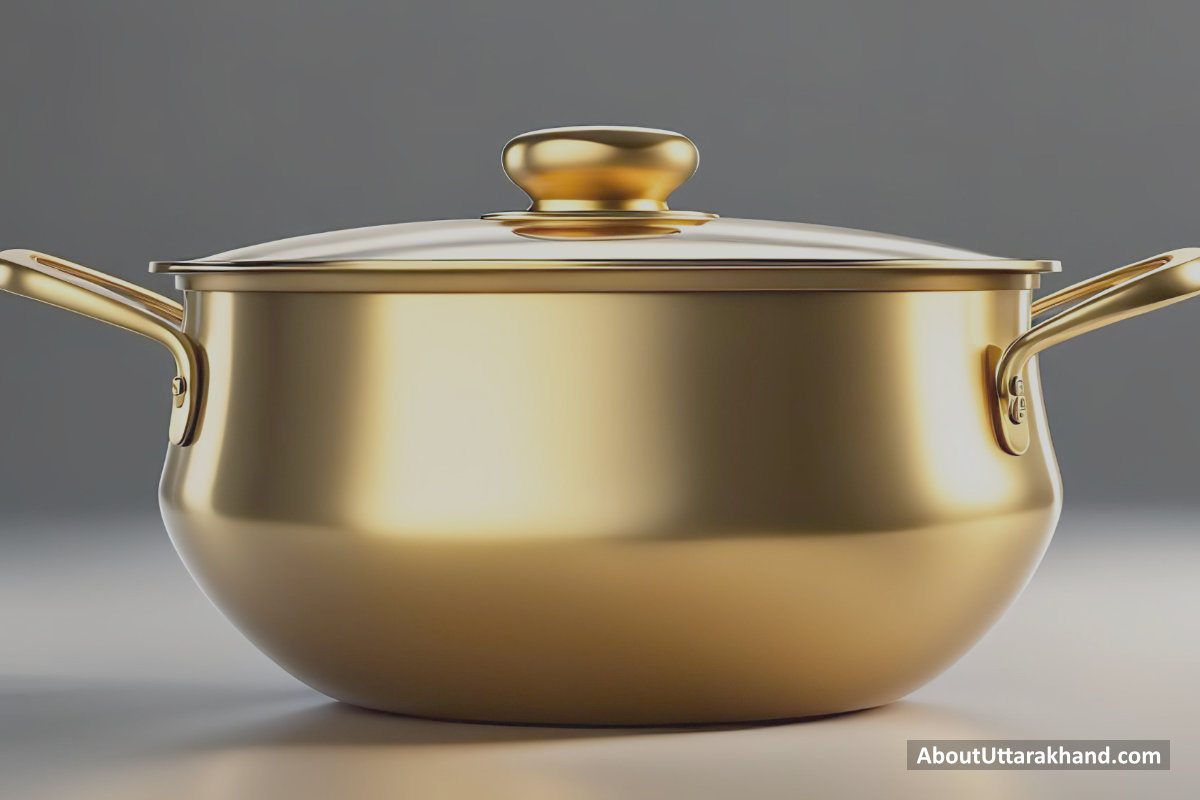
Bhagona - Traditional Utensils Of Uttarakhand | Photo: AboutUttarakhand.com
The brass bhagona is an excellent representation of the region's rich culinary history because to its adaptability and distinctive style. Traditional kitchens would not be complete without this brass cooking pot, which combines practicality with cultural importance.
One element that sets the brass bhagona apart from regular cooking pots is its lid. In addition to keeping heat in while cooking, its cover lets flavours stew gently, which brings forth their full potential in the finished dishes. The principal metal, brass, is selected for its extended lifespan in the kitchen and outstanding heat conductivity.
From making stews and curries to storing food for later, this tool is indispensable in the kitchen. It embodies the pragmatism and adaptability needed for traditional cooking methods and is multi-functional, making it a mainstay in Uttarakhand households.
The brass bhagona is important for more than just its practical use; it is also culturally significant. As a result of its enduring value and symbolic significance, it is frequently passed down through the generations as an heirloom. As a work of art in its own right, the bhagona may have been elevated to the status of a work of functional art due to the elaborate engravings or designs that adorn its brass surface.
Lastly, the brass bhagona perfectly captures the spirit of traditional cooking in Uttarakhand by combining functionality, cultural importance, and artistry. This time-tested bowl is still doing its part to honour and preserve the region's illustrious culinary history.
Cast Iron Kadai

Cast Iron Kadai - Traditional Utensils Of Uttarakhand | Photo: AboutUttarakhand.com
The cast-iron kadai is one of the most durable and multipurpose culinary tools in traditional Uttarakhandi kitchens. This cast-iron implement has quickly become a go-to for a wide range of meal prep tasks, but especially for veggies and curries.
There are a number of benefits to using cast iron. Because of its strength and ability to spread heat uniformly, the kadai can be used for long-term, constant cooking. Cast iron's one-of-a-kind quality gives the food a deep, rich colour, which is both visually appealing and enhances the flavour.
The Cast Iron Kadai can cook with very little oil, which is one of its standout qualities. This goes hand-in-hand with healthy cooking methods and brings out the best in the ingredients' inherent flavours. The kadai's shape is perfect for low and slow cooking, which brings forth the full flavour of food by letting flavours develop and marry.
Beyond its functional use, the Cast Iron Kadai is highly regarded in the culinary traditions of Uttarakhand for its cultural significance. It becomes a representation of history and ties to family when passed down through the years. Traditional cooking methods in the area are holistic, and the health benefits of using cast-iron cookware, such as adding iron to the meal, further support this.
Finally, the Cast Iron Kadai is more than a cooking tool; it's evidence of the culinary brilliance of the Uttarakhandi people. Its sturdy construction, adaptability, and health advantages make it a perennial favourite in kitchens, satisfying both traditionalists and those with a focus on modern health.
Cast Iron Tawa

Cast Iron Tawa - Traditional Utensils Of Uttarakhand | Photo: AboutUttarakhand.com
As a more sustainable and healthful substitute for contemporary non-stick pans, the beloved Cast Iron Tawa makes a triumphant return to the traditional kitchens of Uttarakhand. The traditional tawa is a multi-purpose cooking equipment made of cast iron that is most often used to make flatbreads such as rotis, parathas, and others.
When compared to non-stick pans coated with Teflon, which are harmful to health, the Cast Iron Tawa is clearly superior. Because it uses so little oil for cooking, it encourages a healthy, nutrient-dense diet. In keeping with the region's focus on eco-friendly and holistic lifestyles, cast iron is a safe and natural option because it does not contain any dangerous chemicals.
More than just a healthy food, the Cast Iron Tawa is a significant food. It is an enduring symbol of the rich cultural and culinary history of Uttarakhand, encapsulating the knowledge of time-honored methods of preparation. An enduring emblem of continuity and family traditions, the tawa is built to last and has a classic style.
This Cast Iron Tawa is perfect for making both simple rotis and more complex parathas, demonstrating how adaptable this instrument is in the kitchen. The flatbreads always turn out perfectly in terms of texture and flavour because of how evenly the heat is distributed.
To sum up, the Cast Iron Tawa serves as a functional and nutritious cooking tool and represents the traditional ideals of the Uttarakhandi way of life. It is a cherished and long-lasting part of the region's culinary heritage, since it exemplifies a harmony between ecological consciousness, health, and culinary genius.
Chakki

Chakki - Traditional Utensils Of Uttarakhand | Photo: AboutUttarakhand.com
A hand-operated flour mill known as the Chakki represents the traditional and eco-conscious lifestyle of the Uttarakhandi people and their dedication to self-sufficiency in the home. This tool, made of hefty, uneven stone and wood, is an essential part of the age-old ritual of milling grains into flour, which is essential for producing bread and other staples.
The utilisation of local resources is highlighted by the Chakki's construction materials, which include thick, rough stone and wood. The use of locally sourced, eco-friendly materials is in keeping with the principles of sustainable living in Uttarakhand, and it also guarantees life and durability.
Grains may be ground using the Chakki, demonstrating the usefulness of this age-old implement. The ability to make one's own flour at home encourages independence and lessens reliance on outside sources. When people use the Chakki by hand to grind their flour, it brings them closer to the source of their food and makes the process more intimate.
The Chakki has cultural importance beyond its practical use. In Uttarakhandi homes, it serves as a focal point, a symbol of continuity with the past and a connection to traditional activities. When the hand-operated Chakki is in motion, it makes a familiar and reassuring sound that echoes the community's resiliency and ingenuity.
As a cultural and symbolic artefact in Uttarakhand, the Chakki is used for more than just cooking. By keeping alive the age-old process of flour-making, it promotes independence and helps people feel more connected to their heritage.
Chalni

Chalni - Traditional Utensils Of Uttarakhand | Photo: AboutUttarakhand.com
Simple yet essential, the brass chalni exemplifies the area of Uttarakhand's dedication to accuracy in cooking. Whether it's made of metal or bamboo, this sieve is an essential tool for filtering liquids and sifting flour in the making of regional cuisine.
Traditional implements can be adapted to suit local resources, as shown by the Brass Chalni's use of both bamboo and metal. Using materials like metal, which is admired for its durability, or bamboo, which is renowned for its flexibility and sustainability, the Chalni can meet many culinary demands while staying faithful to the history of traditional craftsmanship in Uttarakhand.
Because of the importance of accuracy in classical cuisine, the Brass Chalni was meticulously designed. In flour-based meals, this simple instrument ensures a smooth texture, and in local delicacies, it helps achieve the ideal consistency. Uttarakhandi cuisine is known for its meticulous attention to detail, and this fine mesh and durable construction are prime examples of that.
The Brass Chalni served a practical purpose, but it also has cultural importance. Symbolising continuity and serving as a link to the past, it is passed down through generations. Utilising the Chalni, with its conventional shape and function, brings one closer to the ancient practices and ceremonies of Uttarakhandi cuisine.
Finally, the Brass Chalni is a perfect example of the precise workmanship and practical design that characterise traditional cookery in Uttarakhand. Not only is it a multipurpose kitchen tool, but it also helps with making regional specialties and provides a physical connection to the history and culture of the area.
Dona and Pattal
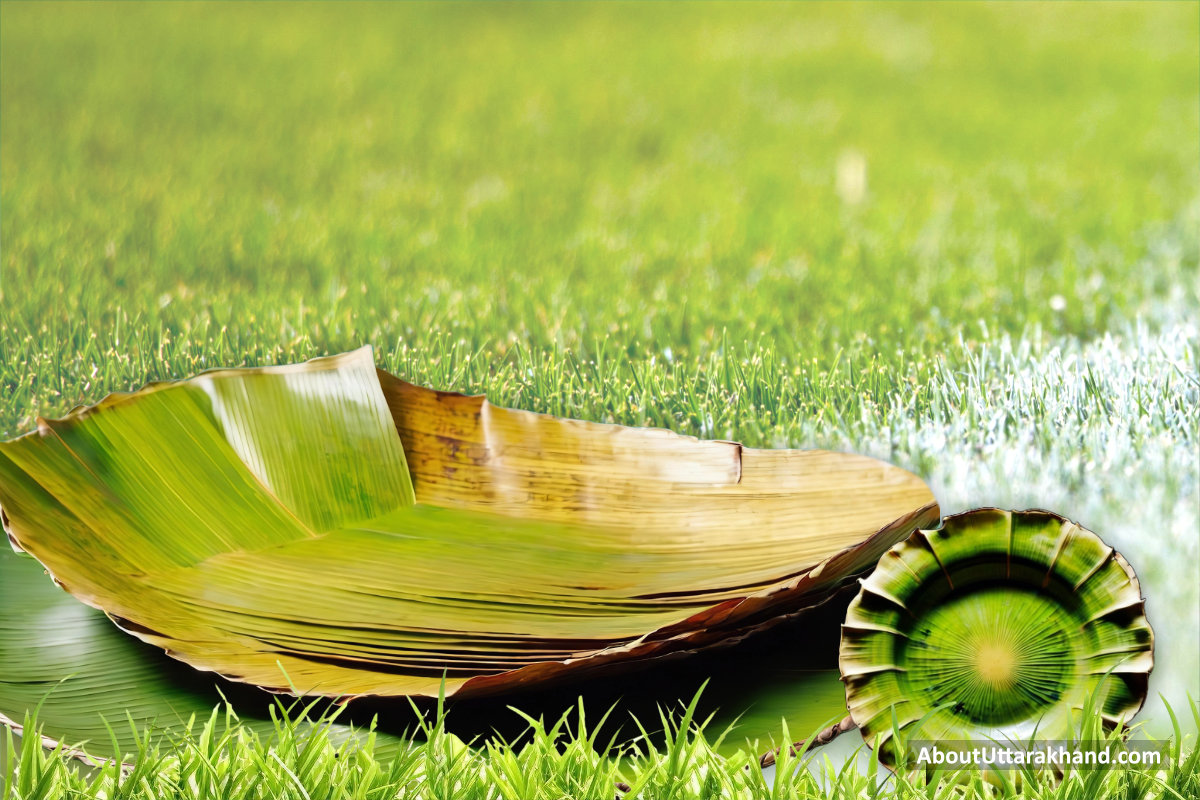
Dona and Pattal - Traditional Utensils Of Uttarakhand | Photo: AboutUttarakhand.com
A long-standing and environmentally conscious culinary practice in Uttarakhand is the use of dona and pattal, traditional bowls and plates made from sal leaves. Sustainable practices and environmental consciousness have been embodied by these items for ages, making them vital to the region's culture. Dona and Pattal, crafted from the fallen leaves of the sal tree, are ideal substitutes for traditional disposable plates because they are biodegradable, lightweight, and environmentally beneficial.
Dona and Pattal made from sal leaves, are an example of Uttarakhand's eco-friendly approach to reusing and recycling materials. In this area, sal trees are plentiful, and making disposable cutlery out of their fallen leaves shows a commitment to living in harmony with nature while also reducing human influence on the environment.
Dona and Pattal are perfect for both casual dinners and more formal celebrations thanks to their lightweight design. As an eco-friendly substitute for plastic and other non-biodegradable materials, their biodegradability keeps them out of the landfill.
Dona and Pattal are culturally significant in addition to being environmentally beneficial. They represent honesty, pragmatism, and a bond with nature; they also have strong roots in local traditions. In Uttarakhand, these implements serve as a symbol of cultural pride and a call to action to protect the region's natural beauty.
Finally, the utilitarian bowls and plates Dona and Pattal represent the cultural history of Uttarakhand, which is concerned with sustainability and environmental consciousness. In a society where environmental issues are a major problem, these time-honored implements provide a model of how cultural practices might help build a better, more sustainable future.
Gagar
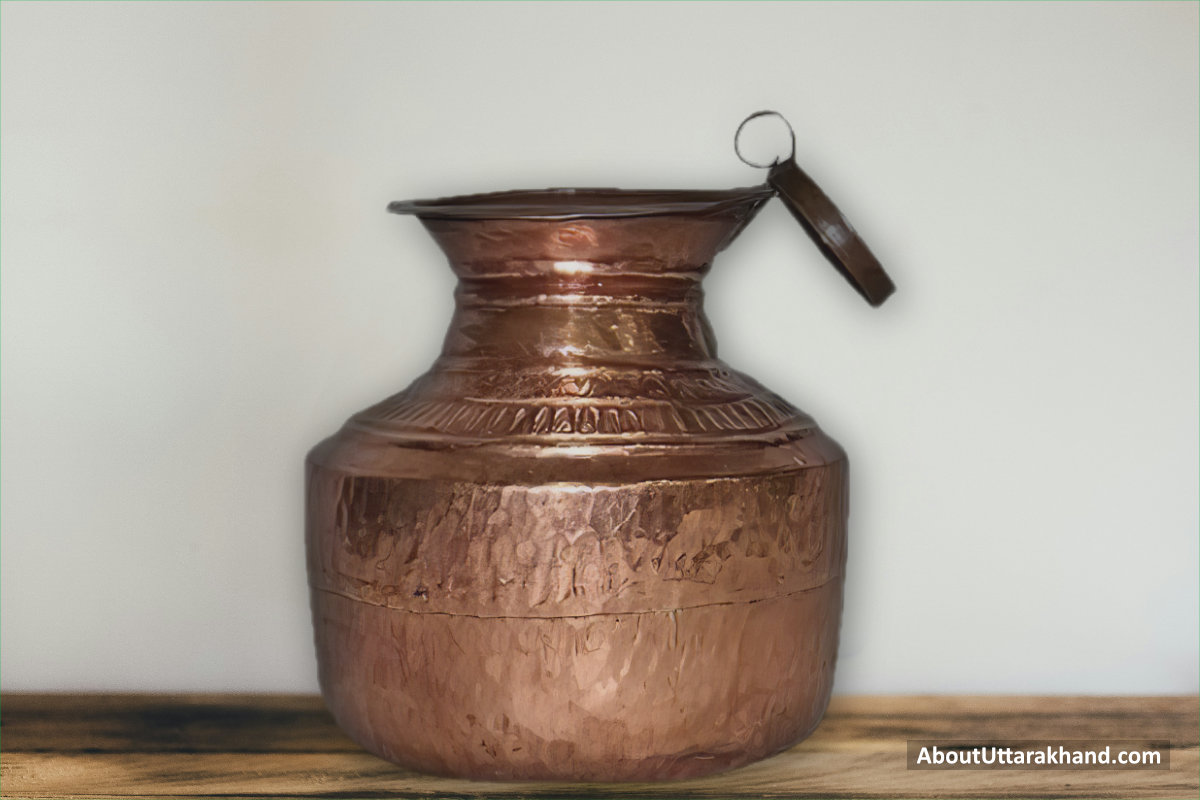
Gagar - Traditional Utensils Of Uttarakhand | Photo: AboutUttarakhand.com
The Gagar, a traditional metal pitcher used to store water in the past, is an important part of both culture and history. Made from copper, brass, or stainless steel, among other metals, the choice of material is based on both function and style. Copper was often chosen because it could naturally clean water because it kills germs. Copper and zinc are mixed to make brass, a strong metal that gave these dishes a decorative touch.
The past of the Gagar is linked to how people in that time saved and used water. Offering water to guests was a big deal in many countries, so these metal pitchers were a sign of hospitality. The skilled metalworkers who made these pitchers showed off their abilities, and the intricate patterns that were carved into them often represented cultural themes and stories.
Modern water holding systems made the Gagar less useful over time. But it is still a treasured object that reminds people of a time when people relied on their craft skills to make everyday things. The Gagar is an example of how functionality, artistry, and cultural meaning have changed over time in everyday life.
Imam Dasta
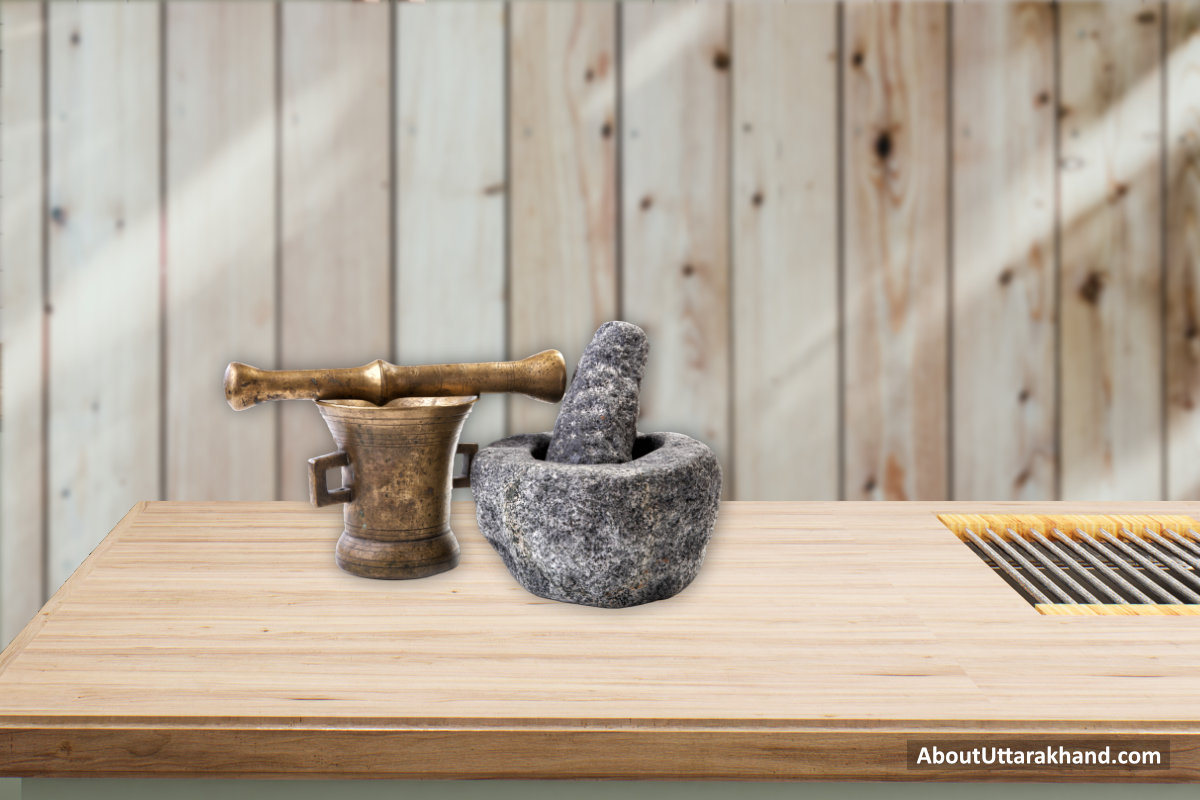
Imam Dasta - Traditional Utensils Of Uttarakhand | Photo: AboutUttarakhand.com
Similar to the Mortar and Pestle, the Imam Dasta is an important cooking tool for grinding up a wide range of herbs and spices. This traditional tool is great for grinding things like ginger, garlic, cilantro, peppermint leaves, and different kinds of dry spices. A strong bowl and a pestle make up its shape, which looks like a mortar. The curved surface of the bowl is perfect for keeping the herbs and spices in place while they are being ground. A sturdy hand tool called a pestle is used to crush and grind the materials into a fine powder.
The Imam Dasta is known for bringing out the aromatic oils and vital compounds in herbs and spices, which make food taste better. In addition to being useful in the kitchen, it has traditional meanings in many different types of food around the world. People think of using the Imam Dasta as an art form because of the exact and rhythmic movements that have been passed down from generation to generation. Because it can be used in many ways, it not only makes it easier to make colourful and tasty food, but it also shows how the people who use it have woven their cultural history into their cooking.
Kansa Thali

Kansa Thali - Traditional Utensils Of Uttarakhand | Photo: AboutUttarakhand.com
The Kansa Thali, a traditional Uttarakhandi plate made of the copper-tin alloy kansa, is a priceless culinary artefact. Kasa is thought to balance the body's energies according to Ayurvedic principles, and it is well-known for its health advantages. The Kansa Thali is a multipurpose dish that brings a cultural element to any meal thanks to its one-of-a-kind design.
Tin imparts durability and copper its antibacterial capabilities; both elements play important roles in the alloy's makeup. In addition to ensuring the Kansa Thali lasts a long time, this mixture also helps it achieve its purported health advantages. You may find that using kansa utensils improves your digestion and general health, according to Ayurveda.
Beyond its practical usage, the Kansa Thali is an object of deep cultural importance. The unique shape of the thali makes food look better and makes eating more enjoyable. When served at a meal, it becomes a cultural statement that brings people of Uttarakhand's holistic lifestyle and long history of tradition closer together.
The Kansa Thali stands as a representation of cultural heritage and prosperity in the Indian state of Uttarakhand. Traditional kansa dining involves centuries-old rituals that value well-being and peace as guests enjoy their meals. There is timeless wisdom in Uttarakhand's traditional utensils, and the Kansa Thali is a living example of it with its cultural importance and health benefits.
Ketli

Traditional Utensils Of Uttarakhand | Photo By: About Uttarakhand
Tea is deeply ingrained in Uttarakhandi society, and the Ketli, a diminutive traditional tea kettle, is a treasured possession in many homes. The brass, copper, or aluminium Ketli adds to the cultural richness of tea-making while simultaneously serving its functional purpose.
Traditional utensils were diverse and adaptive to local resources, as shown by the choice of materials used to create the Ketli, which can be brass, copper, or aluminium. Aluminium is a lightweight alternative, while brass and copper both contribute to effective heat conduction. No matter what metal you choose, the Ketli will make brewing a breeze.
The Ketli is culturally significant in addition to its practical usage. Chai is more than a drink; it's a social ritual, and this cup captures that spirit. On social occasions, the Ketli becomes the centre of attention, serving as a vessel for tea making and sharing. Ketli whistling is a familiar sound in Uttarakhandi families, signifying moments of connection, discourse, and comfort.
In Uttarakhand, the Ketli represents continuity of culture, as it brings people of all ages together around a common appreciation of chai. Its ubiquitous presence in homes captures the region's cultural identity and social spirit while also highlighting the pragmatic side of tea-making. A feeling of community and shared heritage is fostered when the Ketli whistles and steams, echoing the age-old practice of chai in Uttarakhand.
Letan
'Letan' refers to a special tool used to churn buttermilk that is stored in a wooden container called 'Paredu.' The letan is a cleverly designed attachment made of a string with small sticks on both ends. It is attached to a 'rodi,' a wooden stick that can be turned. This traditional way shows how simple tools can be used to do useful work in rural areas.
Usually, the letan is put into the wooden bowl, making sure that the small sticks are completely submerged in the buttermilk. The rodi hold the other end of the rope in place. The letan stirs and churns the buttermilk with its connected sticks while the rodi is turned by hand. This makes it easier to separate the butter from the liquid.
This very old method shows how resourceful and environmentally friendly people in country areas are, where hand-made methods are more common than machine-made ones. The letan and rodi system not only show a link to tradition, but they also show how important it is to use tools that are made for the area when farming. They are a perfect example of how cultural heritage and practicality can work together.
Parat
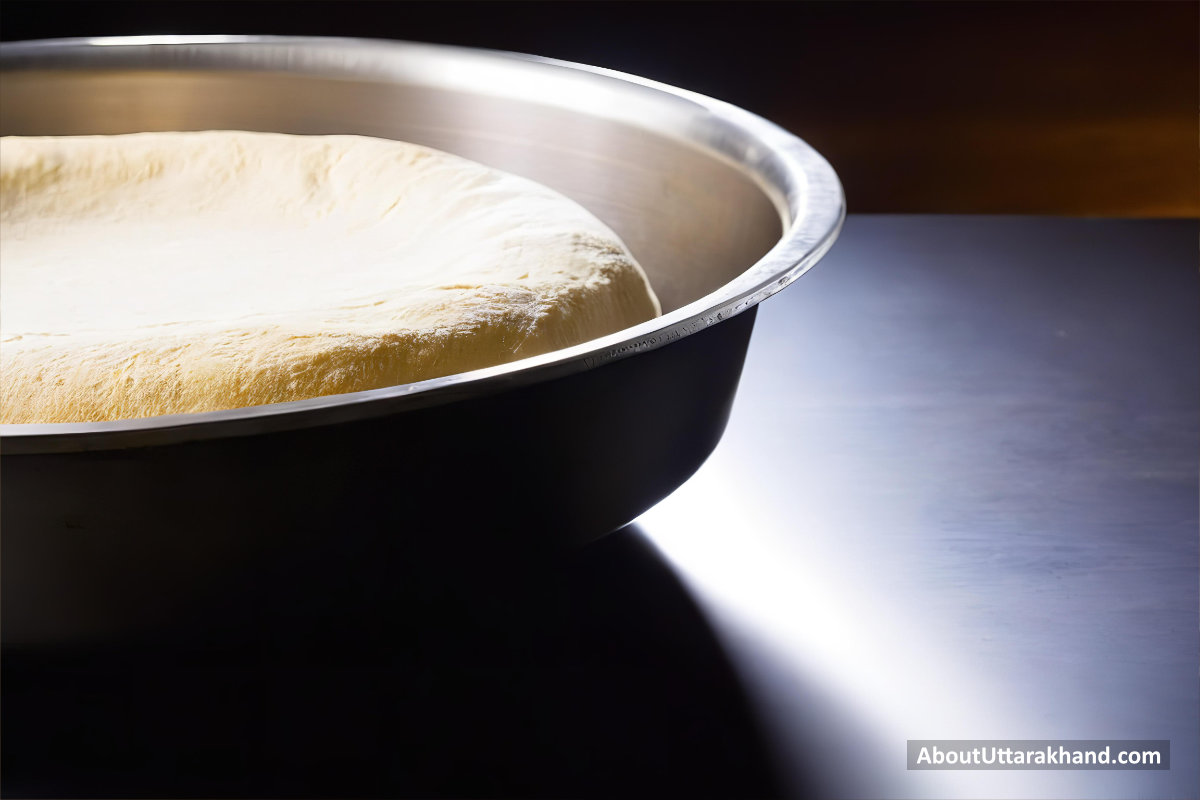
Parat - Traditional Utensils Of Uttarakhand | Photo: AboutUttarakhand.com
The Paraat is a multipurpose kitchen staple, traditional item from Uttarakhand that serves multiple tasks. Paraats are versatile and practical because of their design and the materials used to make them—brass, steel, or aluminium.
The Paraat is at the very core of traditional Indian cooking because it is the essential equipment for making roti dough. You can mix ingredients thoroughly and efficiently because of its wide and shallow shape, which gives you enough of room to knead. Durability is guaranteed by materials like aluminium, steel, or brass, and each metal has its own set of advantages, such as heat retention, strength, or lightweight.
In addition to making dough, the Paraat may be used to cut vegetables and mix ingredients for pakodas, among other things. It simplifies a lot of different kinds of cooking and is thus a popular tool in Uttarakhandi families.
The materials used to make the Paraat are a reflection of the region's ingenuity and flexibility. Metals like aluminium are sleek and contemporary, while steel and brass add to a more classic look. Regardless of its metal, the Paraat represents efficiency and pragmatism in the culinary traditions of Uttarakhand.
Ultimately, the Paraat represents more than just a kitchen tool; it is an emblem of the strong work ethic, flexibility, and adaptation that are intrinsic to the cuisine of Uttarakhand. The Paraat is an integral part of daily life, serving as a link to the region's rich culinary legacy, whether it's for kneading dough or making snacks.
Paredu

Paredu - Traditional Utensils Of Uttarakhand | Photo: AboutUttarakhand.com
A basic tool in the kitchens of Uttarakhand is the Paredu, a deep circular pot used to make butter from curd. Made of metal or wood, this container can hold 20 to 50 litres of curd, which is a lot of butter extraction.
In order to extract the butterfat from the buttermilk, the curd is vigorously agitated using the churning process, which is aided by the Paredu. The circular, deep shape of the bowl allows for efficient churning, which turns the curd into butter with a velvety texture and a golden hue. Both tradition and practicality are taken into account while selecting the material, be it wood or metal. For a more classic, country vibe, go with wooden Paredu; for longevity and little maintenance, go with metal.
Because butter is both culturally and nutritionally important in Uttarakhand, the Paredu exemplifies the importance of dairy in Hindu cuisine. Traditional buttermaking from the curd is a labor-intensive process that brings people together, strengthens community ties, and protects regional heritage.
More than just a means of transportation, the Paredu has taken on a symbolic and cultural significance in Uttarakhand, serving as a means of bringing people together. People are connected to the culinary traditions of Uttarakhand through its continued importance in butter preparation, which in turn maintains traditions. The inherent significance of traditional utensils in maintaining cultural identity and social customs is symbolised by the Paredu, which has deep roots in daily life.
Parothi

Parothi - Traditional Utensils Of Uttarakhand | Photo: AboutUttarakhand.com
Parothi, a little container made to store curd for a long time, is a special among Uttarakhand's traditional implements. The Parothi, with its small volume of 5 to 10 litres, is vital for preserving curd and making sure it is available for a long period. Craftspeople known as 'Chuner' would traditionally go from village to village, using a labor-intensive procedure, to create Parothi.
Made entirely of wood, the Parothi-making procedure is as labor intensive as it is beautiful. It all starts with a piece of wood that is turned by a water turbine and a drill to make a hollow, spherical core. Even the outside of the wood is precisely carved to improve its look, demonstrating the level of attention to detail that goes into the workmanship. Handcrafting each Parothi requires meticulous attention to detail and can take up to five or six hours per vessel.
The practical function of the Parothi is just one aspect of its universal importance. The craft of Uttarakhand is encapsulated in it, with each vessel serving as a monument to the knowledge and expertise that has been handed down through the years. The Parothi is a cultural artefact that serves to bring people together and maintain the integrity of traditional cooking tools in Uttarakhand due to its one-of-a-kind design and expert craftsmanship.
Patila

Patila - Traditional Utensils Of Uttarakhand | Photo: AboutUttarakhand.com
Patila, the deep, round-bottomed cooking pot, a staple in Uttarakhand's traditional kitchens, is a versatile utensil crafted from materials such as brass or copper. This pot, often used for various culinary tasks, holds particular significance in the preparation of millet, rice, and boiling water.
Made from brass or copper, the pot exemplifies the region's preference for metals that not only conduct heat efficiently but also impart unique flavors to the food. The choice of materials also ensures durability and longevity, making the pot a reliable companion in the kitchen.
The pot's deep and round-bottomed design serves multiple purposes. It is ideal for cooking millet, allowing even heat distribution and thorough cooking. Similarly, it serves as a vessel for boiling water, contributing to daily household activities. Additionally, the pot's versatility extends to rice preparation, showcasing its adaptability in various culinary tasks.
Beyond its utilitarian role, the deep cooking pot holds cultural significance in Uttarakhand. It becomes a symbol of traditional cooking practices, connecting generations through shared culinary experiences. The pot's presence in the kitchen is a testament to the enduring importance of these utensils in preserving the essence of Uttarakhand's rich culinary heritage.
In conclusion, the deep, round-bottomed cooking pot reflects the functional and cultural dimensions of traditional utensils in Uttarakhand. Its use in everyday cooking not only fulfills practical needs but also underscores the enduring connection between the people and their culinary traditions.
Rodi
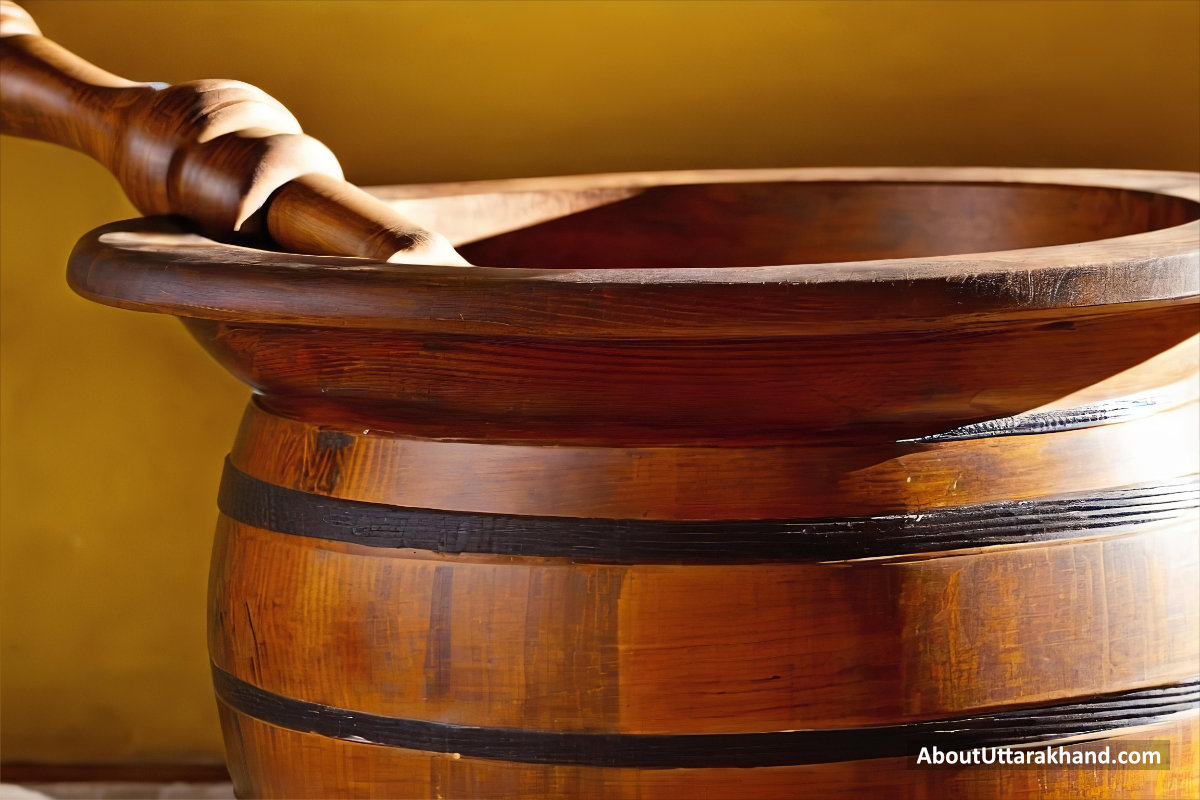
Rodi - Traditional Utensils Of Uttarakhand | Photo: AboutUttarakhand.com
Churning curd to make buttermilk requires a simple yet vital tool—a long wooden stick. Rodi is an integral part of Uttarakhandi traditional cooking. Using this wooden stick, an age-old process has been carried out to turn curd into butter and buttermilk.
Churning, which involves aggressively agitating the curd to separate the butterfat from the buttermilk, relies heavily on the use of a long wooden stick. The curd is blended thoroughly, and the desired consistency is produced by using the length of the stick as leverage to efficiently churn it.
In Uttarakhand, making butter using a long wooden stick is a culturally significant activity, since it reflects the region's long history of using traditional ways. The utensil's understated design complements the area's eco-conscious emphasis on reusing and recycling materials.
Beyond its functional purpose, the wooden stick takes on the symbolic importance of a family heirloom and the links of community. One of the most common ways that people in Uttarakhand come together is to churn buttermilk, which is an essential component of many traditional dishes.
In conclusion, the traditional utensils of Uttarakhand are best represented by the long wooden stick that is used to churn curd. The historic significance, practicality, and simplicity of the dish highlight the region's efforts to maintain its culinary legacy and bring people together via shared norms and customs.
Sil Batta
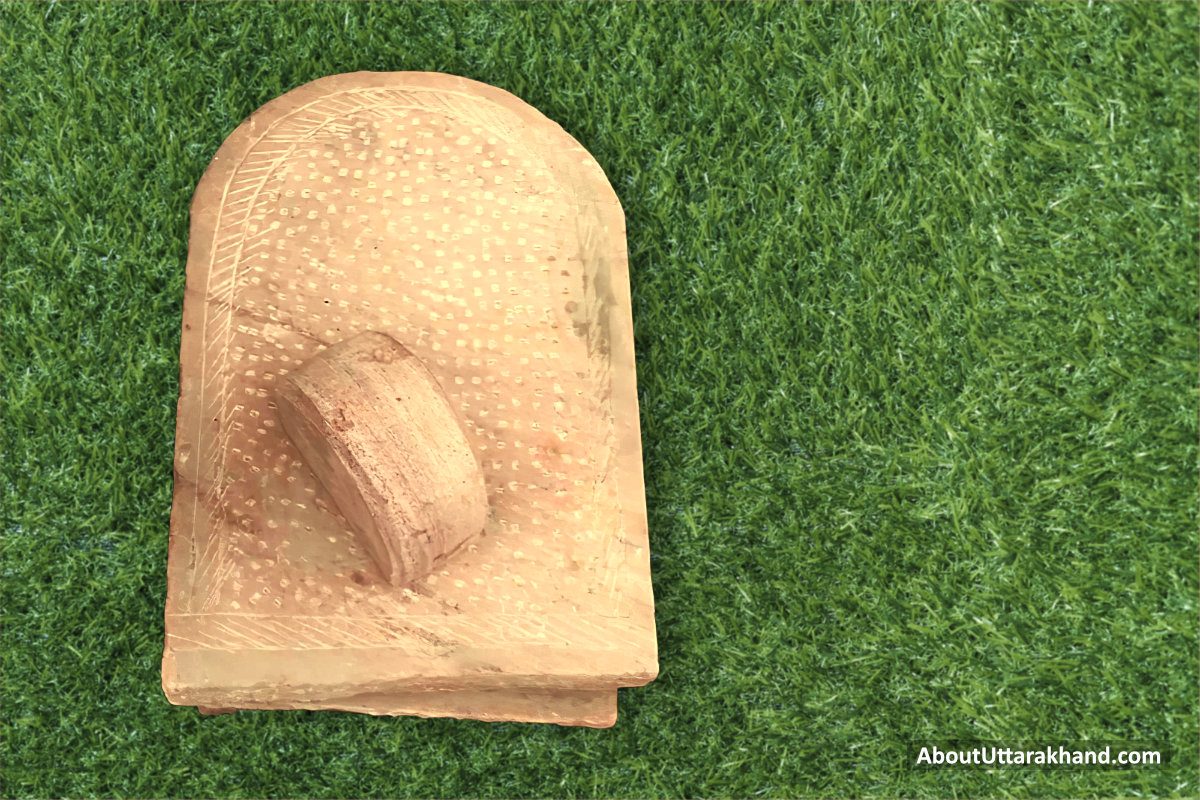
Sil Batta - Traditional Utensils Of Uttarakhand | Photo: AboutUttarakhand.com
The Sil Batta is an essential tool in many Uttarakhandi kitchens. It exemplifies the region's dedication to maintaining traditional recipes' distinctive tastes. Built from sturdy stone, this grinding stone is an essential tool in Uttarakhandi cooking. It's used to crush grains and spices, giving the food a fragrant and flavorful edge.
The sil atta is a strong, precisely carved grinder that efficiently grinds spices and grains while retaining their flavour and aromatic oils. Its utility is secondary to the sensory experience it provides, which facilitates a connection to the ancient ways of food preparation through the resonant sounds created by the grinding process, which reflect the hill cuisine.
The use of solid stone in the construction of the Sil Batta is an indication of the region's dependence on its own resources and also adds to the longevity of the vessel. The inherent characteristics of the stone improve the grinding process, making for a finer powder while keeping the components' real flavours and textures intact.
The Sil Batta becomes more than just a functional item; it becomes a cultural relic that represents the unbreakable bond between the people of Uttarakhand and their traditional cuisine. Stories of history and authenticity are told by the sounds and scents radiating from the Sil Batta when families assemble around the grinding stone.
Lastly, the Sil Batta isn't just a grinding stone; it holds a treasure trove of Uttarakhandi flavours and cultural memories. Using it in the kitchen not only keeps traditional cooking methods alive, but it also connects the past with the present, conserving the essence of Uttarakhand's rich culinary legacy.
Suppa

Suppa - Traditional Utensils Of Uttarakhand | Photo: AboutUttarakhand.com
When making traditional dishes from Uttarakhand, such as rice, dal, wheat, and ragi, the traditional sieve known as the Suppaa is an indispensable tool. This tool, made from bamboo sticks, is devoted to the painstaking process of cleaning raw foods of contaminants like dirt and stones.
The Suppaa's bamboo structure highlights the region's ingenuity and commitment to sustainability, as it makes use of resources that are readily available for cooking. The delicate bamboo sticks are intertwined to form a mesh that efficiently separates grains from contaminants, guaranteeing that the raw ingredients are of high quality and purity.
Beyond its obvious usefulness, the Suppaa is essential for preserving the grains' nutritional value. The Suppaa helps produce clean and unadulterated ingredients by carefully sorting through raw food resources; this sets the stage for traditional, healthy Uttarakhandi cuisine.
As a sign of utmost care and cleanliness in the kitchen, the cultural relevance of the Suppaa goes beyond its practical use. The importance of natural and unprocessed foods in the region is reflected in its position in the kitchen, which is in line with the cultural ethos of Uttarakhand.
Finally, the suppaa is an understated yet essential tool in the kitchens of Uttarakhand. Traditional utensils play an important role in preserving authentic culinary practices in the region. Their use of bamboo, practical functionality, and cultural importance all contribute to this.
Metal Used And Physical Construction Of Traditional Utensils Of Uttarakhand
Handmade in Uttarakhand, traditional utensils feature a wide range of materials selected for their specific qualities. Brass, copper, iron, and kansa are the most common metals used to make these cookware items. The cleanliness of stored liquids and cooked food is guaranteed by the antibacterial qualities of brass and copper.
Many kitchen utensils and grinding tools are made of iron because of its long lifespan and enduring quality. The use of kansa, a copper and tin alloy, not only makes the cutlery last longer, but it also improves your health in general. Traditional wooden cutlery like the 'Paredu', 'Rodi', 'Parothi' and 'Tumri' highlight the regionand's eco-conscious relationship with its verdant woodlands.
Delicate handiwork that has been handed down through many generations has gone into their physical creation. Brass and copper utensils often have engravings of folklore, everyday life, and regional themes. Careful consideration was given to the size and form of each implement so that it could perform its designated task, guaranteeing that it would be useful in everyday life.
Use Of Traditional Utensils Of Uttarakhand In Daily Life
Traditional utensils in Uttarakhand are more than just a curiosity; they play an essential role in people's lives. In order to maintain a steady supply of clean water despite the mountainous terrain, the 'Bantha' and 'Gagar' play a crucial role in water storage and transportation. The rhythmic motion of the 'Paredu' and 'Rodi' holds great significance in the traditional butter extraction method, which serves as a link to the people's agrarian heritage.
The unusual combination of metals used to make the 'Kansa Thali' is thought to provide medicinal as well as cosmetic benefits. The native spices and grains are ground to perfection in the Sil Batta, preserving their uniqueness. Crafted for efficient cooking, the 'Patila' and 'Kadai' keep watch while the locals prepare meals that have been passed down through generations.
Uttarakhandi cuisine is known for its accuracy and artistry, which is enhanced by the use of utensils like as the 'Chalni' and 'Tumri'. While representing tradition, the 'Chakki' also shows how households grind their staple items on their own. Natural resources used to create Dona and Pattal demonstrate the area's dedication to eco-friendly policies.
At parties and festivities, the 'Bhagona' is the star attraction, representing the happiness that comes from eating together as a community. With its understated elegance, the 'Ketli' prepares tea that is more than a drink; it is a ritual that brings people together.
To Conclude
Traditional Uttarakhandi utensils are more than just utensils; they are artefacts that preserve the regionand's history, culture, and identity. Every piece of Uttarakhandi cookware, from the 'Bhaddu' to the 'Ketli', showcases the ingenuity, skill, and eco-consciousness of the local population. In the face of encroaching modernity, these implements of cooking and serving stay firm, protecting the indigenous traditions of the Himalayan region.
The indigenous inhabitants of Uttarakhand are laying the groundwork for a sustainable and culturally vibrant future by returning to these time-honored practices and preserving their culture. Uttarakhandi traditional utensils are more than artefacts from another time; they are representations of a strong and adaptable culture that has the potential to flourish in the contemporary world.

Belle Fable, keeps your trend ahead!
Gaumukh Glacier
The stunning Gaumukh Glacier, in the Uttarkashi region of Uttarakhand, India, is situated close to Gangotri and framed by the towering Garhwal Himalayas. Glaciers like this one attract tourists, hikers, and nature lovers from all over the globe because of the deep religious significance they have for Hindus as the headwaters of the holy Ganges River. The ascent to Gaumukh is an adventure in body and spirit, providing an opportunity to commune with the holy and the natural world.
Nandhaur Wildlife Sanctuary
The Nandhaur Wildlife Sanctuary is a haven for wildlife and stunning scenery, set in the tranquil hills of Uttarakhand. This sanctuary, in the Nainital District close to Haldwani, is a paradise for people who appreciate nature and animals. Its varied habitats, which include grasslands, ponds, and thick forests, have earned it recognition across its 269 square kilometers of territory.
Sonanadi Wildlife Sanctuary
The Sonanadi Wildlife Sanctuary invites animal lovers and nature lovers to come and enjoy the quiet beauty of Uttarakhand's serene surroundings. Hidden in the Nainital District, not far from Nainital, lies a refuge that begs to be discovered. Its varied wildlife and flora make this area, which covers around 301.18 square kilometers, a popular destination for ecotourists and those interested in biodiversity.
Binsar Wildlife Sanctuary
The Binsar Wildlife Sanctuary is a haven for wildlife and a monument to Uttarakhand's rich biodiversity, is situated in the picturesque Kumaon Himalayas. Nature lovers and wildlife aficionados will find this refuge, situated near Almora in the Almora District, to be a paradise. Covering about 47.04 square kilometers, it is famous for its verdant forests, varied fauna, and breathtaking views of the Himalayan mountains in the distance.
Tawaghat Wildlife Sanctuary
The Tawaghat Wildlife Sanctuary is a haven for adventurers and ecotourists, tucked away in the foothills of the towering Himalayas. This hidden gem of a sanctuary is located near Dharchula in Uttarakhand's Pithoragarh District. Despite its relatively tiny size (around 70 square km), this animal sanctuary is just as magical as any other.
Chilla Wildlife Sanctuary
.The Chilla Wildlife Sanctuary, located on the banks of the pure Ganges River, is a living monument to the beauty and variety of Uttarakhand's natural landscape. This sanctuary is a paradise for anyone who love nature and wildlife; it is located in the Pauri Garhwal District, close to Rishikesh. Covering over 249 square kilometers, it is a major wildlife sanctuary in the state that provides a peaceful haven amidst the majestic Himalayas.







